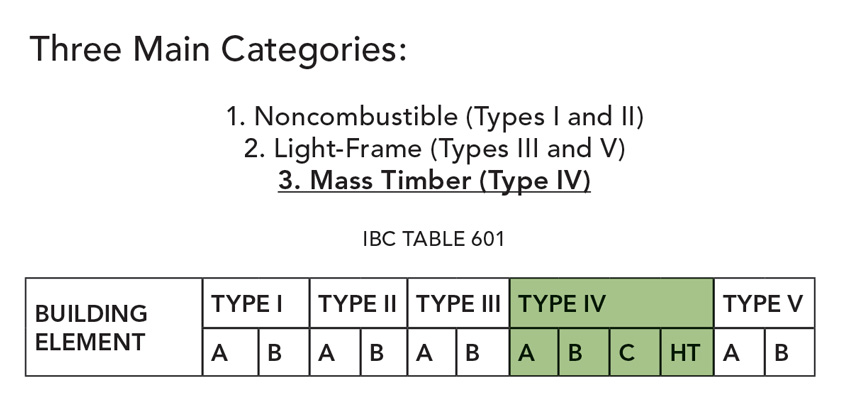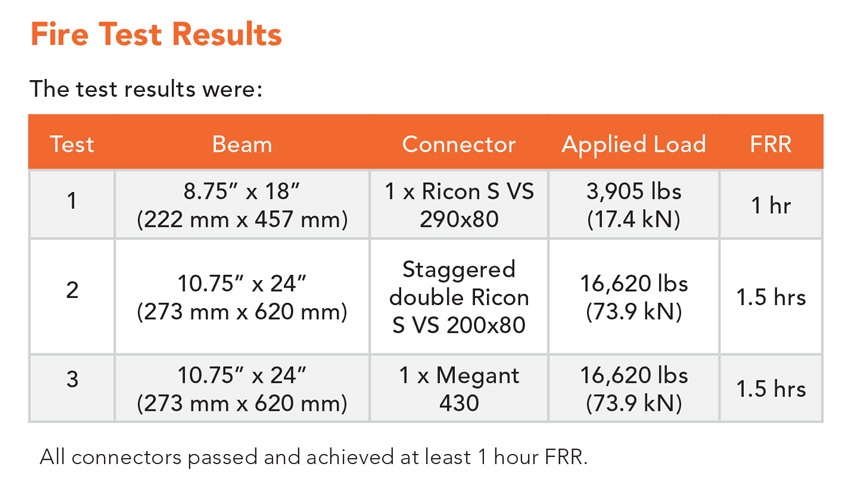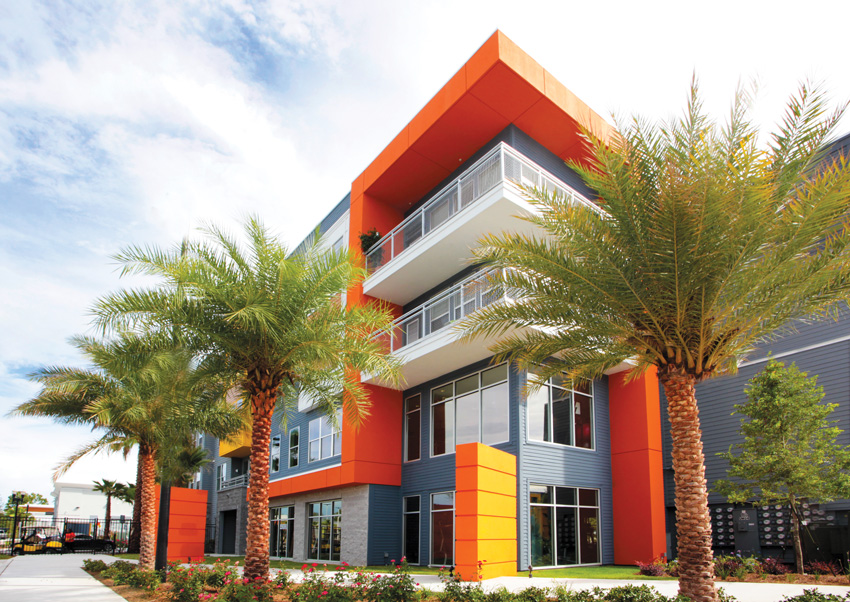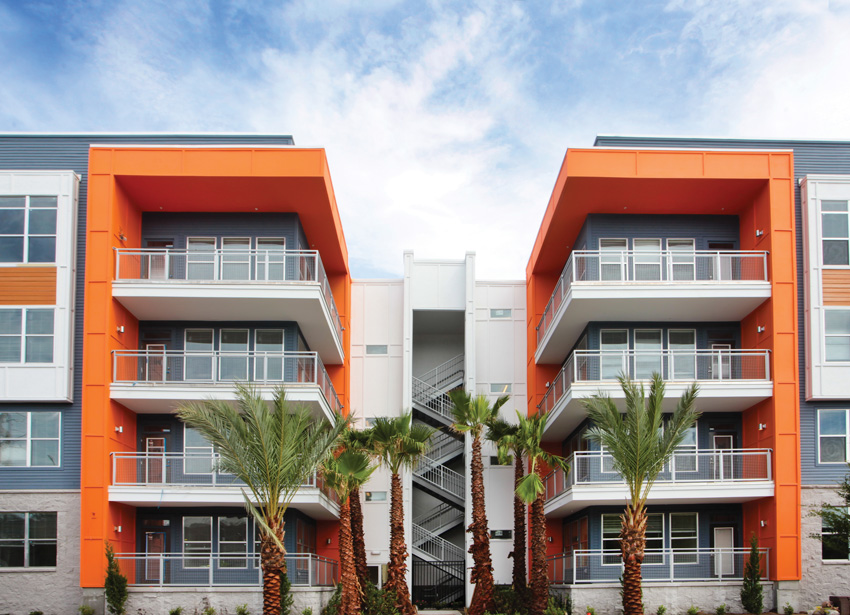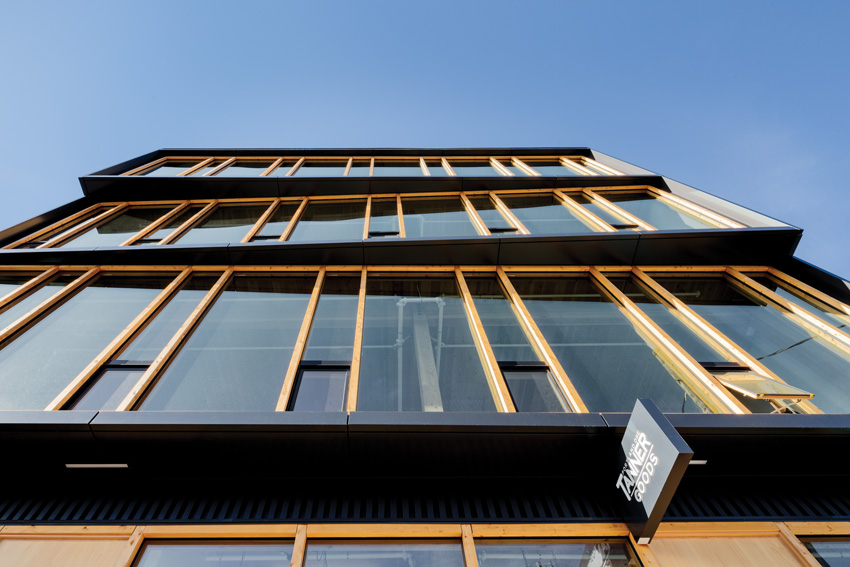Wood and Evolving Codes: The 2018 IBC and Emerging Wood Technologies
Building codes are evolving to support new technological developments for one of our oldest building materials
![]() Continuing Education
Continuing Education
Use the following learning objectives to focus your study while reading this month’s Continuing Education article.
Learning Objectives - After reading this article, you will be able to:
- Discuss provisions in the International Building Code (IBC) intended to ensure that wood buildings provide an acceptable level of safety.
- Evaluate techniques that make it safe for designers to increase heights and areas of building projects beyond IBC base limits.
- Identify the advantages of wood-frame and mass timber structures during hazardous events.
- Explain how advances in wood products and building systems are influencing the evolution of building codes.
Increasingly, designers, builders, and building owners are turning to one of our oldest building materials: wood. Valued for its versatility, low carbon footprint, and aesthetic qualities, not to mention its cost performance, wood has long been a preferred choice for constructing durable structures that are resilient in the face of hazardous conditions. However, in modern times, structural wood has been largely confined to residential and low-rise commercial construction, despite its proven structural performance and ability to endure seismic and wind events. Recent innovations and subsequent code changes are expanding the use of structural wood beyond these established sectors.
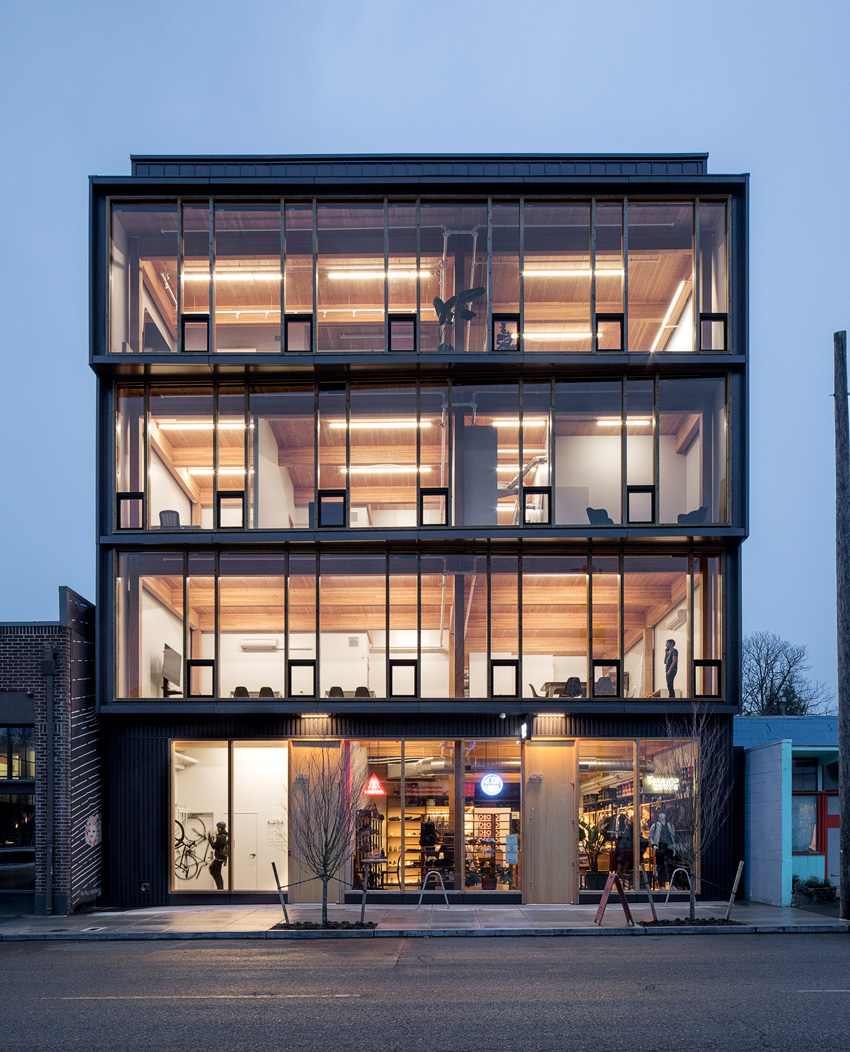
Photo: Jeremy Bitterman, courtesy of LEVER Architecture
Designers are taking advantage of innovative wood products that showcase the natural beauty of wood.
Using wood in nonresidential buildings is not a completely new idea, but rather a revival. Innovative new construction techniques are expanding the use of lumber; these techniques utilize engineered wood products such as cross-laminated timber (CLT), nail-laminated timber (NLT), dowel-laminated timber (DLT), and structural glued-laminated timber (glulam). These “mass timber” products have great structural capability and inherent fire resistance, and interest in mid- and even high-rise wood buildings that incorporate these technologies is growing rapidly in Canada and the United States. Testing and validation of these products, in addition to many new examples coming online, is driving increasing confidence from both the public and local code authorities. Recent code changes reflect the growing body of research that validates these systems for structural performance and for contribution to life safety during extreme events, such as fires, hurricanes, and earthquakes.
The Code Update Process
When the International Building Code (IBC) was introduced in 2000, it consolidated three regional model building codes into one uniform code that has since been adopted by most jurisdictions. It increased the possibilities for wood construction by (among other things) recognizing additional fire protection techniques, consolidating the maximum allowable areas and heights from the three legacy codes into one (thus increasing what’s allowable in some jurisdictions), and allowing the use of wood in a wider range of building types. In subsequent versions of the IBC, even more opportunities have been created where additional fire protection features are used. Even so, the pioneering nature of building design is such that there are always architects and engineers seeking to innovate, and it is common for project teams to request (and be granted) variances for designs not covered by the code that nonetheless meet its intent and provide accepted levels of safety. Given the code’s three-year amendment cycle, this performance pathway is necessary to keep pace with advancements in building systems, materials, and construction practices.
The 2018 IBC was released in September 2017 and certain states and local jurisdictions have adopted it; however, the code landscape is uneven, and many states and jurisdictions are following IBC 2015, 2012, or even older versions of the code. The 2018 IBC references newer versions of important standards. One of these is ANSI/AWC NDS-2018: National Design Specification for Wood Construction. Produced by the American Wood Council (AWC), this resource was first issued in 1944. Today, it includes requirements for design of a full range of wood products based on up-to-date research and testing, and it is used to guide design of wood structures around the world.
NDS 2018 itself references ASCE 7-16: Minimum Design Loads and Associated Criteria for Buildings and Other Structures. This important resource, published by the American Society of Civil Engineers (ASCE), describes the means for determining dead, live, soil, flood, tsunami, snow, rain, atmospheric ice, earthquake, and wind loads, and their combinations for general structural design. It is widely referenced by building codes.
While the IBC is updated on a three-year cycle, the ASCE 7 is typically on a six-year cycle. The NDS is updated at least every six years, but sometimes more often to address new load provisions developed by ASCE 7 or new products such as CLT.
Advocating for Change
Although the International Code Council (ICC) and the building industry in general have long recognized the benefits of wood as a building material, emerging technologies such as CLT are still new to many people, and until the 2015 IBC, they were not explicitly introduced into building codes.1
It’s important to understand that mass timber systems and technologies such as CLT have been fully tested and verified and are allowed under current codes. Fortunately, architects, engineers, developers, building owners, and others are championing CLT and other new uses of wood, including light frame, and sharing resources and research to support this burgeoning interest in mass timber building design, including the use of wood in taller buildings. The Think Wood Research Library, an online database that includes nearly 1,000 research documents, can help architects, engineers, and other industry professionals design and build safe, high-performing wood structures. The research contained in the database covers seismic, fire safety, and other performance aspects of wood members and systems. The library also includes reports and research papers on other design topics, including acoustics and vibrations, energy and environment, and building codes and cost.
Another specific resource for designers seeking to design code-compliant wood structures is the 2018 Code-Conforming Wood Design (CCWD). Produced in partnership with the ICC, the AWC developed this document to demonstrate that modern building codes allow large, multistory wood buildings in many common occupancy uses with nothing more than a basic understanding of key code provisions required. CCWD summarizes the most common requirements for wood construction in commercial buildings according to the 2015 IBC. The 2018 version of CCWD, based on the 2018 IBC, has been released and is available at “CCWD_Complete_2018.”
In this quickly evolving industry, a number of individuals and entities, including engineering firms, academic institutions, standards organizations such as the National Fire Protection Association (NFPA), and government research organizations such as the U.S. Forest Service Forest Products Laboratory, have been driving innovation with testing that demonstrates and improves upon the structural, seismic, wind, and fire safety performance of mass timber. These efforts have led to a great deal of new information in a short period of time, and these groups are committed to sharing this information in order to drive best practices in this emerging field.
To promote and facilitate code changes based on the building science of taller wood buildings, the ICC approved the creation of the Ad Hoc Committee on Tall Wood Buildings in 2016. This balanced group includes building officials, fire officials, architects, fire protection engineers, and industry experts. “Tall wood” is an industry term that refers to the use of wood products in buildings greater than six stories; hence, the committee was charged with investigating the feasibility of and taking action on developing code changes for tall mass timber buildings. Since its formation, the Committee on Tall Wood Buildings has reviewed extensive literature on tall wood buildings, including the results of domestic and international testing. The committee has proposed 14 code changes for the 2021 IBC cycle.2 (A summary of these proposed changes can be viewed at www.awc.org/tallmasstimber)

Image courtesy of Think Wood
Nail-laminated timber, which consists of dimension lumber stacked on edge and nailed together, is one of several engineered wood products being used in today’s buildings.
Fire Protection
To understand the building codes’ fire protection provisions, it’s important to remember that codes divide construction into five types:
- Type I and II: All building elements must be noncombustible.
- Type III: Exterior walls must be of noncombustible materials.
- Type IV (Heavy Timber): Exterior walls must be of noncombustible materials, and interior building elements are of solid or laminated wood without any concealed spaces.
- Type V: Exterior walls, interior walls, and structural members may be of any material permitted by code.
The IBC and ICC require all building components within a particular type of construction to provide the same level of fire protection regardless of materials used. As a starting point, the IBC specifies a basic allowable area based on a single story, the type of construction, and occupancy classification. It then permits increases to allowable areas based on features of the building, including the addition of an automatic sprinkler system, side yard open space, fire walls, augmented exiting, and additional stories.
For example, the code allows low-rise, two-story business and mercantile buildings of wood construction to be of unlimited area when they are equipped with an automatic sprinkler system throughout and have 60 feet of fire-separation distance between the building and all property lines. Residential wood buildings with sprinklers and exterior walls made from fire-retardant-treated wood (FRTW) can be up to five stories in height and have additional “levels” when mezzanines are included. Under the 2018 IBC, mezzanines are permitted to have a floor area up to one-third of the floor area below and considered part of that story, and under certain conditions in dwelling units can be up to one-half of the floor area of the room below. The code also permits the use of wood for many features in buildings required to be of a noncombustible construction type, often even whole roof structures, based on other safety features.
Under the 2018 IBC, designers can use fire walls to create separate building portions that do not exceed the height and area limits set by code. This option can be exercised when sprinklers either aren’t an option or don’t afford the necessary increases for the project’s use and site characteristics. In Type V Construction, fire walls are permitted to be of wood-frame construction, allowing designers to divide the structure into separate buildings for purposes of size, each subject to its own height and area limits.3 Therefore, the size of a building can theoretically be doubled while maintaining the same construction type.
In addition to sprinkler and open frontage increases, a designer’s options also include increasing to a higher type of construction, which might include the use of fire-resistive construction throughout the building, fire-retardant-treated lumber for exterior walls, or heavy timber construction.
Rated Assemblies
There are several types of fire-resistive assemblies and components within a building. These include vertical assemblies (walls), horizontal assemblies (floors and roofs), and structural frame members (columns and beams). In most cases, these components and assemblies are required to have either a 1- or 2-hour fire-resistive rating. Fire-resistive construction is typically designated as the number of hours a representative test assembly or component will resist a standardized fire exposure when tested in a laboratory. One of the standards used for measuring fire resistance of building assemblies is ASTM E 119.
IBC Section 703.3 provides several methods for determining fire resistance of building elements, including but not limited to the following:
- Fire-resistance designs documented in approved sources.
- Prescriptive designs of fire-resistance-rated building elements, components, or assemblies as prescribed in Section 721.
- Calculations in accordance with Section 722.
Approved sources include documents such as AWC’s Design for Code Acceptance (DCA) series. DCA 3: Fire-Resistance-Rated Wood Floor and Wall Assemblies describes how interior and exterior wood-frame walls and wood I-joist floors can be used to meet building code requirements for fire-resistance-rated assemblies (see Figure 4).
IBC Section 721 provides prescriptive fire-resistance-rated wall and roof/ceiling assemblies for both traditional and engineered wood-frame assemblies.
The fire resistance of wood assemblies may also be calculated using the provisions of Section 722.6 of the IBC, which is based on the known fire resistance of many tested assemblies and assembly components. The calculation approach in this section is limited to 1 hour and is helpful in retrofit situations. The IBC also references Chapter 16 of the NDS, which has a broader application for calculating fire resistance of exposed wood members up to two hours.
By designing a building to meet the provisions of Type III Construction rather than Type V, the designer is able to take advantage of greater allowable heights and areas. For example, fire-retardant-treated wood (referenced in IBC Section 2303.2) is permitted in different locations in different types of construction, as noted in Sections 602.3 and 602.4. In Type III and Type IV Construction, this includes exterior walls and interior walls and partitions. In Type I and Type II Construction, fire-retardant-treated wood is allowed in nonbearing partitions, nonbearing exterior walls where a fire-resistive rating is not required, and portions of the roof construction. In Type I Construction, heavy timber roofs are permitted without fire-retardant treatment.
Heavy timber construction combines the beauty of exposed wood with the strength and fire resistance of heavy timbers. Modern versions include sawn stress-grade lumber, tongue-and-groove decking, CLT, NLT, and glulam. Under the code, fire resistance is achieved by using wood structural members of specified minimum size and wood floors and roofs of specified minimum thickness and composition; by providing the required degree of fire resistance in exterior and interior walls; by avoiding concealed spaces; and by using approved fastenings, construction details, and adhesives for structural members. Type IV Construction utilizes heavy timber elements as the structural members. This type of construction recognizes the inherent fire resistance of large timber and its ability to retain structural integrity in fire situations. The fire resistance in heavy timber construction typically comes from surface char, which insulates the wood member and leaves a significant portion of the member to continue supporting the structure during a fire.
The 2018 IBC allows CLT of a certain thickness (at least 4 inches for floors, 3 inches for roofs, and the minimum thickness specified in the manufacturing standard for walls) within Type IV construction. Fire-resistance testing has confirmed that CLT, like heavy timber, chars at a rate that is slow and predictable, maintaining its strength while serving its intended function for structural safety. In May 2018, the APA published the 2018 edition of ANSI/APA PRG 320: Standard for Performance-Rated Cross-Laminated Timber, an American National Standard that provides requirements and test methods for qualification and quality assurance of CLT. One of the changes in PRG 320-2018 addresses differences in fire performance for certain adhesives, which can lead to the early exposure of uncharred wood at lamination lines during the late stages of a fire; consequently, the updated standard mandates a compartment fire test protocol and an additional small-scale delamination fire test.4 CLT products manufactured to the standard have been recognized as code compliant in the 2018 IBC and will not delaminate during a fire.
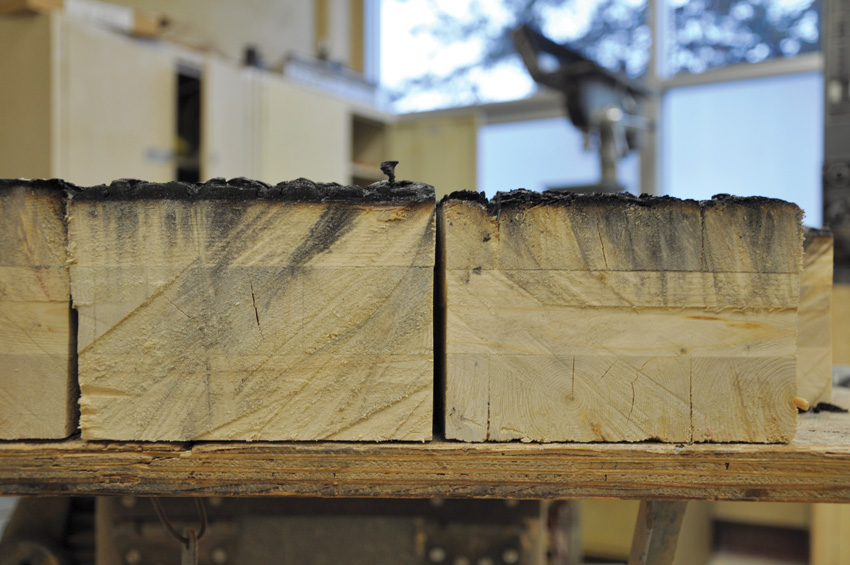
Photo courtesy of FPInnovations
Fire tests show that CLT chars slowly at predictable rates.
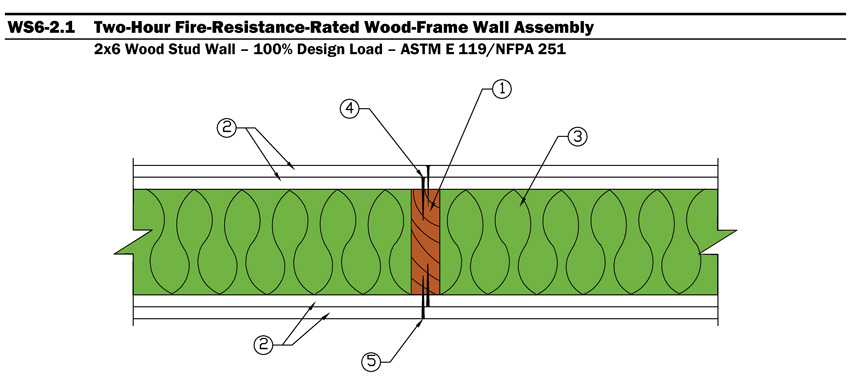
Image courtesy of the AWC DCA3: Fire-Resistance-Rated Wood Floor and Wall Assemblies
The American Wood Council provides details for fire-resistance-rated wood-frame wall and floor/ceiling assemblies, such as the 2-hour assembly pictured here.
Fire Safety during Construction
The construction phase of a project presents unique risk scenarios that make the building more vulnerable than it is once complete, when features such as fire doors, gypsum wall board, smoke alarms, and sprinklers are in place.
Minimum safety precautions for fire during construction and the protection of adjacent public and private properties are provided in IBC Chapter 33. This section includes, among other things, provisions for fire extinguishers, standpipes and means of egress. The International Fire Code also includes detailed requirements.
In buildings under construction, arson and hot work are the most common causes of fire. For this reason, site security, rigorous procedures for workers, and access to fire hydrants are essential. Educating workers so they understand the vulnerabilities and how to avoid dangerous situations is also a must. To that end, the Construction Fire Safety Coalition (CFSC) provides resources through an online database on best practices than can help reduce the incidence and severity of fires during construction.
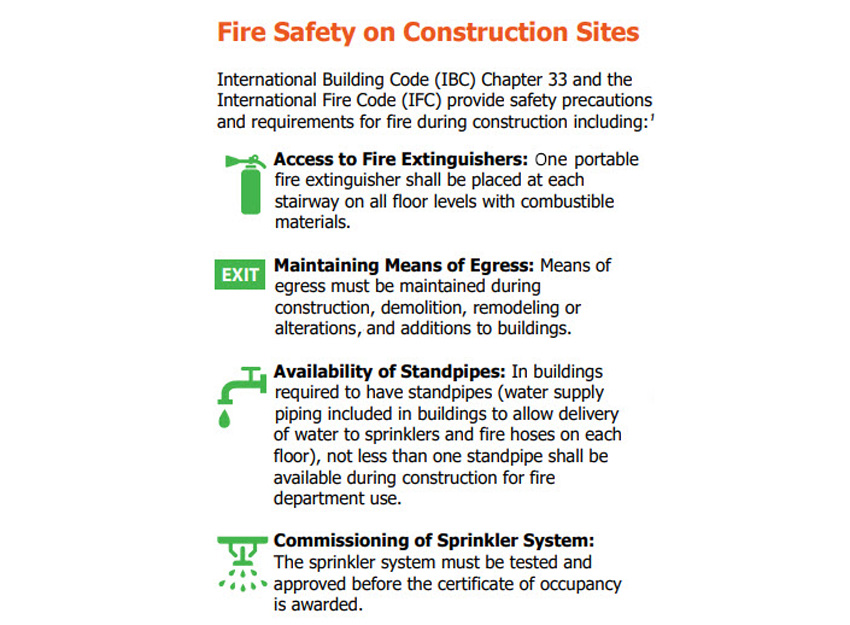
Image courtesy of American Wood Council
Chapter 33 of the IBC provides minimum safety precautions for reducing the risk of fires during the construction process.
Seismic Performance
Years of research and building code development have proven that wood-frame and hybrid structures can meet or exceed the most demanding earthquake design requirements.
Most earthquake damage is caused by seismic waves that force the ground to move and cause the building foundation to shake. Forces generated in an earthquake are proportional to the structure’s weight. Thus, the overall magnitude of earthquake-induced forces that a building must resist is generally less for lighter buildings—and wood is substantially lighter than other common building materials. The fact that wood buildings tend to have numerous connections means they have more load paths, and there is less chance the structure will collapse should some connections fail. These many connections also give wood buildings inherent ductility.
The correct design of elements such as frames, shear walls, diaphragms, and their connections to each other is of utmost importance as earthquake forces “search out” the weak links between structural members. Post-earthquake investigations conducted by the Federal Emergency Management Agency (FEMA) have shown that a large proportion of the serious earthquake damage to modern structures is not linked to design deficiencies, but rather occurred “because contractors did not construct structural elements and nonstructural components as required in the design drawings and specifications.”5
A report on damage to wood-framed buildings in Southern California earthquakes shows that wood-framed structures, including single-family homes, generally perform well during seismic events.6 An inspection of schools after the 1994 Northridge earthquake revealed that overall, the facilities fared very well, with most of the damage consisting of nonstructural or structural but repairable damage.7
More recently, shake table testing has verified the favorable seismic performance observations of wood-framed buildings.8 For these tests, both light-frame and CLT buildings were subjected to earthquake simulations while sensors measured factors such as displacement distance between components and the degree of bending of building elements. In particular, shake table tests are showing multistory buildings made with CLT perform very well, just like their light-frame predecessors. One seven-story building that was tested on a shake table in Japan survived 14 earthquake simulations with minimal damage.9
The University of California San Diego has also been conducting extensive shake table testing on a variety of buildings, studying everything from base isolation to the effect of earthquakes on nonstructural components to fire spread. In particular, researchers are conducting tests in order to develop and validate a seismic design methodology for eight- to 20-story tall mass timber buildings. A two-story CLT building has been tested using a rocking wall system that enables CLT walls to counter lateral loads, and the research team plans to build and test a 10-story CLT building by 2020. The results of these and other tests will continue to inform building code provisions.10
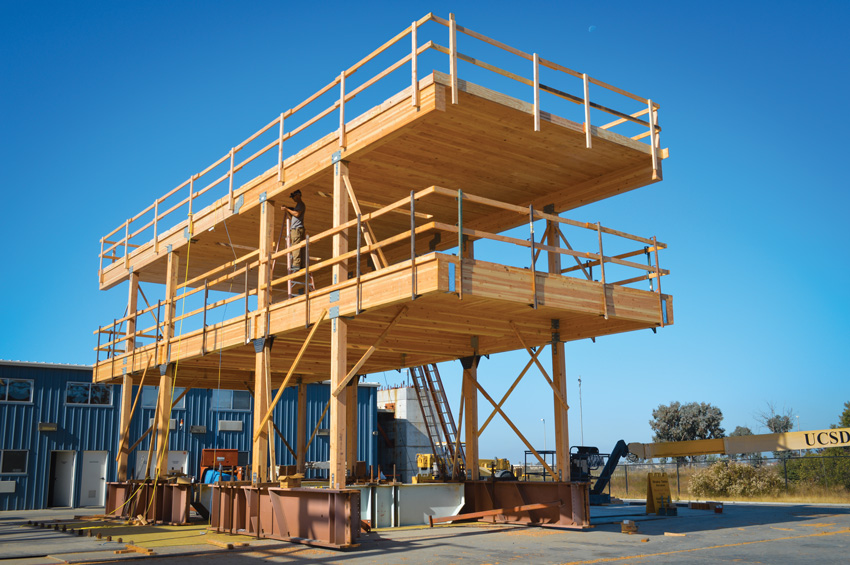
Photo courtesy of UCSD Jacobs School of Engineering
Shake table testing exposes full-scale buildings to simulated seismic events.
Wind Resistance
In addition to superior seismic performance, wood buildings can be designed to effectively resist high winds. Wood’s elastic limit and ultimate strength are higher when loads are applied for a shorter time period, which is typically the case in high wind events. When wood structural panels such as plywood or OSB are properly attached to lumber framing and used to form diaphragms and shear walls, they also form some of the most solid and stable roof, floor, and wall systems available. However, in order for the diaphragms and shear walls to be effective, all of the related components—including framing, structural panel sheathing, and inter-element fastening details—must be designed and installed correctly. The success of the entire system depends on the quality and quantity of the connections, which transfer loads through the building to the foundation, and ultimately, to the ground.
The loss of inadequately connected roofing materials and sheathing is a leading cause of failure in wood-frame buildings during high-wind events.11 Once the roof sheathing has been pulled off its framing, the load path is interrupted and the diaphragm ceases to function as part of the lateral load-resisting system.12 In fact, the entire loading dynamics of the building will have changed due to this breach. This change in loading dynamics negatively affects the lateral design of the building.
Surveys of wood-framed buildings following Hurricane Katrina revealed that “failure to construct to prevailing building codes” contributed to a significant portion of the damage. The surveys revealed the following fatal flaws: improper or inadequate fastening of roof sheathing to rafters, failure to provide an adequate load path from roof to wall or wall to foundation, and improper installation of shingles (not enough fasteners and/or inadequate spacing of fasteners).11 In many cases, these shortcomings led to total building loss.
Major disasters often lead to significant code changes. Following Hurricane Andrew, which struck Florida in 1992, damage assessment teams found roof sheathing panels with as few as four fasteners. This event inspired the creation of the Florida Building Code. A FEMA Mitigation Assessment Team (MAT) report following the 2004 hurricane season in Florida showed that new homes built to the 2001 Florida Building Code performed well, even when subjected to winds as high as 150 miles per hour. This was in part due to adequate connection of the roof deck to trusses and rafters.12
With proper detailing, it is relatively easy to meet code requirements for safety during high wind and seismic events. The AWC’s Special Design Provisions for Wind and Seismic (SDPWS) is directly referenced by the IBC for the required design of lateral force-resisting systems, such as nailed wood-frame shear walls and diaphragms that resist lateral loads.
Sound Transmission and Acoustics
Wood offers excellent acoustic control; hence it can be used to enhance and/or mitigate sound. In residential buildings, IBC 2018 provides a minimum design requirement for unit-to-unit acoustical protection between floors. It requires a sound transmission class (STC) rating and impact insulation class (IIC) rating of 50. STC describes how effective a wall or floor/ceiling assembly is at blocking airborne sound transmission from one room to the next. IIC describes how effective a floor/ceiling assembly is at blocking structure-borne noise created by impacts on a floor through a ceiling to the room below. The higher the number, the more effectively sound is blocked. Wood buildings can be designed to meet or exceed minimum sound transmission requirements depending on the expectations of the developer, buyers, and tenants. Designers sometimes aim for ratings higher than those required by code, particularly for luxury multifamily units.
Wood-frame construction is particularly efficient in residential buildings where sound insulation is required. Attaching gypsum board to walls and ceilings using resilient metal channels significantly reduces sound transmission, as does placing glass-fiber or rock-fiber insulation within wood-frame floor and wall assemblies.13 Wood does provide a “bridge” for sound; consequently, constructions which provide thermal breaks, such as staggered-stud and double-stud construction, are more effective at blocking sound than conventional single-stud construction. In this case, using “resilient connections” can improve acoustic performance. These systems, which include fiberboard sheathing systems, special metal channels, and vibration isolators, convert sound waves into mechanical energy so that less sound is transmitted through the assembly.13
The Evolution of Wood Construction
Wood construction can be divided into three major categories. Light-frame construction, which dominates the residential home industry, consists of many lightweight framing members that are typically nailed together and spaced closely. Post-and-beam construction consists of decking and heavier posts and beams which create a “skeleton” for the building. Compared to the studs in light-frame building, the posts are spaced relatively far apart. Mass timber construction is characterized by the use of heavy timber or engineered panels which form the structural members for the floor, roof, and walls.
In recent years, designers have embraced wood construction for many types of buildings, thanks to innovative and inspiring examples and updates to the building code which have made more uses possible.
Mid-rise and Multifamily
Often used in multifamily projects, podium construction consists of multiple stories of light framing built over a single- or multistory podium of another construction style, usually concrete. Increasingly, developers are turning to wood for their multifamily projects because of the material’s cost performance, environmental footprint, and speed of construction.14
The use of concrete-and-steel podiums allows light-frame construction to be used for mid-rise buildings, and updates in the 2015 IBC (which are unchanged in the 2018 IBC) allow for multistory podiums, making it easier to design multiuse buildings with ground-floor retail.15 Mid-rise buildings are typically categorized as Type V Construction, which allows the use of untreated wood throughout, or Type III Construction. Type III Construction allows the same methods of construction as Type V, except the exterior walls are required to be of noncombustible construction. This allows the use of fire-retardant-treated wood. Many developers and design teams default to wood for mid-rise buildings up to four stories because it is the most economical choice;16 however, with five-story wood buildings permitted in the IBC (six for office occupancy), there has been a marked interest among those who see taller wood buildings as a way to achieve greater density at lower cost. Podium structures in particular, which include multiple stories of residential wood-frame construction over a concrete (3-hour-rated) podium deck, are common among design professionals seeking to incorporate parking, retail, or restaurants into their designs. The specific requirements for using podium construction to increase allowable number of stories are detailed in Section 510 of the IBC.
Schools
The IBC has well-established parameters for light wood-frame schools, which is good news for school districts trying to accommodate increasing enrollment. Accordingly, many who turn to wood-frame construction find that wood offers advantages, such as speed of construction, design versatility, and the ability to meet green building goals. Increasingly, research is also supporting the idea that visual wood in a room promotes the well-being of occupants, reduces stress, and creates a positive environment for learning.
For institutes of higher education, new buildings also provide opportunities to showcase innovative technologies, some of which have been developed at the institutions themselves. For example, the John W. Oliver Design Building, located on the University of Massachusetts, Amherst campus, is one of the first institutional buildings in the Northeast to utilize a mass timber structure. Completed in 2017, the Design Building features an exposed glulam frame, CLT and concrete composite floors, and CLT elevator, stair, and mechanical shafts. A grand CLT stair is also a central focus of the atrium. The UMass Building and Construction Technology program developed some of the CLT technology used in the building, which is already being recognized as a groundbreaking “green” building. Some of its other features include LED lighting paired with optimized daylighting, heat recovery systems, and sustainable landscaping features such as bioswales and raingardens.
Productivity and Health
Wood is a particularly good choice for health-care facilities, especially if the material is left exposed, as it can help buildings feel less institutional and even contribute to healing environments. This idea is backed by research studies which have shown that patients recover more quickly when exposed to “natural” materials and views of nature, and that workers are more productive in so-called “biophilic” settings—those characterized by natural light, natural materials, and views.18
As a case in point, the Herrington Recovery Center is a 21,000-square-foot, 20-bed wood-frame treatment center in Oconomowoc, Wisconsin. The building features cedar and stained wood both inside and outside. Wood ceilings and soffits add warmth to the recreation and sleeping rooms. Exposed glulam beams allow for soaring ceilings, clerestory windows provide natural light, and wood floor systems create a comfortable surface underfoot. In addition to contributing to a warm and healing environment, the use of wood saved both time and money.
The Mountain Equipment Co-op (MEC) headquarters building in Vancouver, British Columbia, illustrates how wood can be used to achieve multiple benefits, including structural integrity and seismic and fire safety, along with environmental and health benefits. The 112,000-square-foot building is a hybrid timber and steel structure which includes floor assemblies made with prefabricated NLT panels. Laminated timber beams and columns are exposed within the building, and an open floorplan and generous glazing bring in natural light and highlight the warmth and beauty of the exposed wood elements. This “natural setting” contributes to the health and well-being of MEC employees and makes the building a pleasant and productive place in which to work.
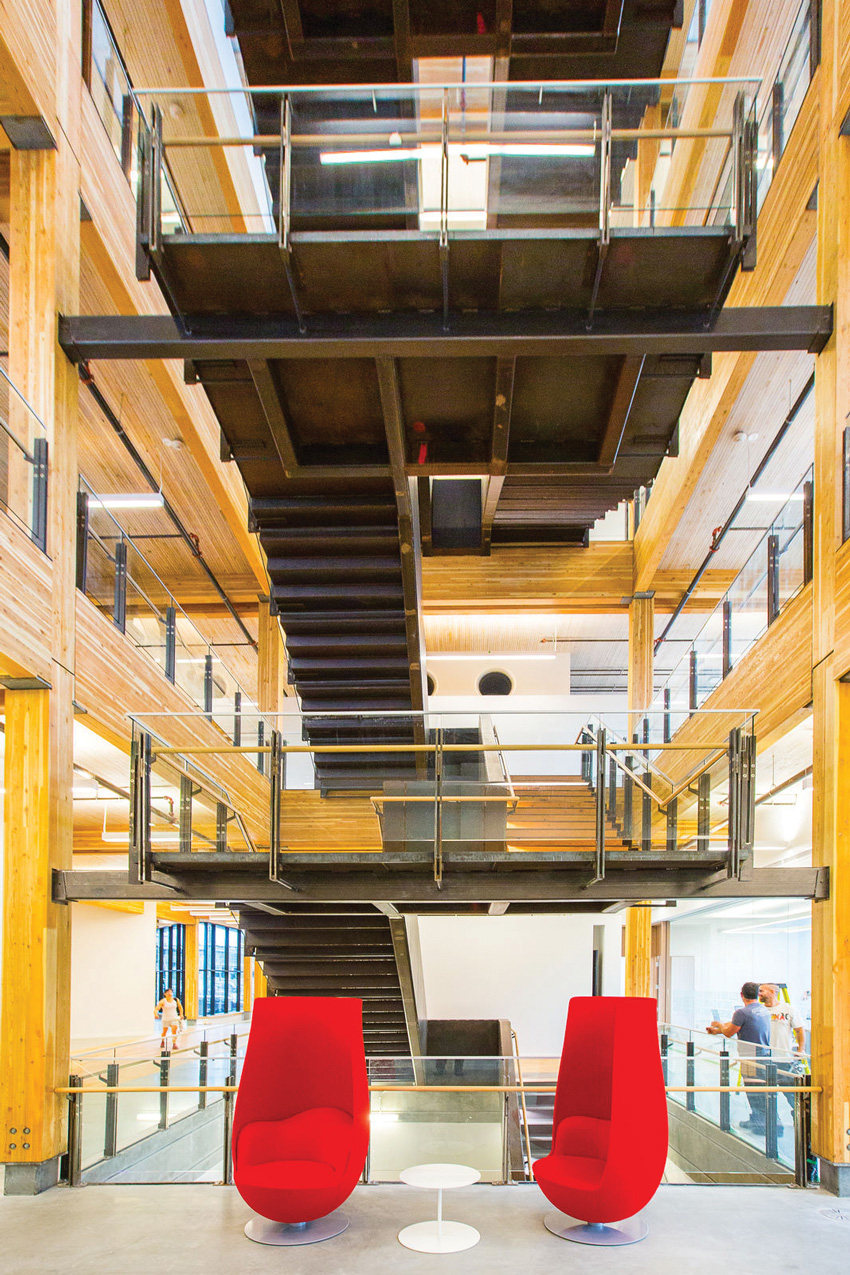
Photo courtesy of KK Law + naturallywood.com
The MEC headquarters building in Vancouver, British Columbia, features an open plan and lots of exposed wood, which contributes to the health and well-being of employees.
Tall Wood Buildings
A 2017 audit on tall mass timber buildings summarizes the plethora of new projects that are either built, under construction, or in the planning stages all around the world, and graphically demonstrates the rising trend of wood buildings that are greater than six stories.
Several wood and wood hybrid buildings are underway or have been recently completed in Canada. For a short time, the 97-foot-tall Wood Innovation Design Center, completed in 2014, was the largest all-timber building in the world. The Arbora complex in Montreal consists of three eight-story, all-timber buildings and integrates housing units with retail in an “urban forest” setting. Brock Commons Tallwood House, a hybrid timber and concrete student dormitory at the University of British Columbia in Vancouver, was just completed. The 18-story building currently holds the record for the world’s tallest mass timber building.
Though lagging behind Canada and Europe, mass timber is starting to make inroads in the United States. These include a range of multifamily structures, office buildings, and educational projects such as the Design Building at UMass described earlier. In Minneapolis, an all-timber, seven-story office building called T3 was completed in 2016. T3 was constructed with NLT panels combined with a spruce glulam post-and-beam frame and a concrete slab. Carbon12, an eight-story residential building in Portland is breaking ground with performance-based testing. This building’s design includes a “buckling-restrained braced frame core” surrounded by a timber and CLT structure.
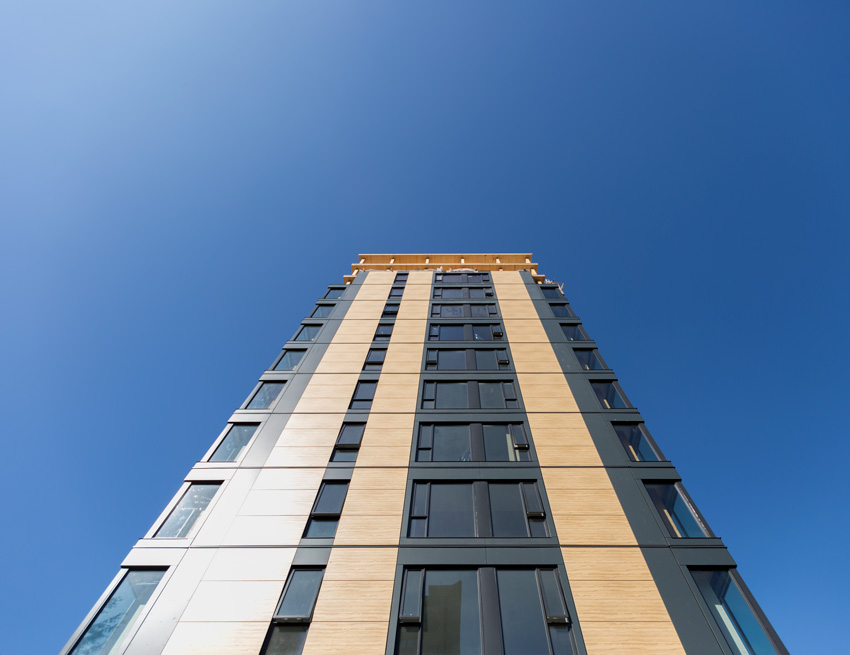
Photo credit: Brudder Productions + naturallywood.com
Featuring a hybrid mass-timber system, Brock Commons demonstrates the application of mass timber in high-rise construction.
Tall Mass Timber Updates in the 2021 Code
In January 2019, the International Code Council (ICC) approved a set of proposals to allow tall wood buildings as part of the 2021 International Building Code (IBC). Based on these proposals, the 2021 IBC will include three new construction types:
- Type IV-A – Maximum 18 stories, with noncombustible protection on all mass timber elements.
- Type IV-B – Maximum 12 stories, limited-area of exposed mass timber walls and ceilings allowed.
- Type IV-C – Maximum 9 stories, all mass timber permitted to be exposed (with a few exceptions e.g. shafts) and designed for a 2-hour fire resistance.
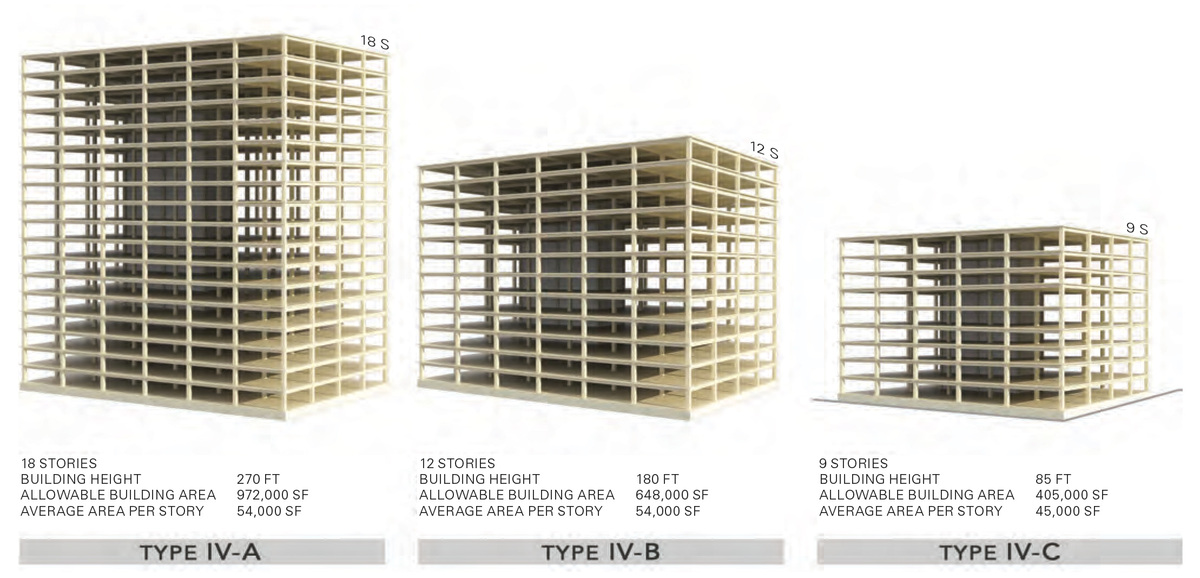
Photo courtesy of atelierjones, LLC
These new types are based on the existing Heavy Timber construction type (renamed Type IV-HT) but with specified hourly fire-resistance ratings for building elements and added levels of noncombustible protection. The code will include provisions for up to 18 stories of Type IV-A construction for Business and Residential Occupancies.
A team of fire experts from the U.S. Bureau of Alcohol, Tobacco, Firearms and Explosives (ATF) working alongside scientists from the U.S. Forest Products Laboratory tested 5 identically furnished, one-bedroom apartments constructed of exposed, partially exposed, and unexposed (protected) five-ply cross-laminated timber (CLT). The rigorous series of fire tests demonstrated that mass timber construction performed equivalent to non-combustible construction and provided valuable data that was used in the development of code change proposals submitted by the ICC Ad Hoc Committee on Tall Wood Buildings (TWB) for the 2021 International Building Code. 17

